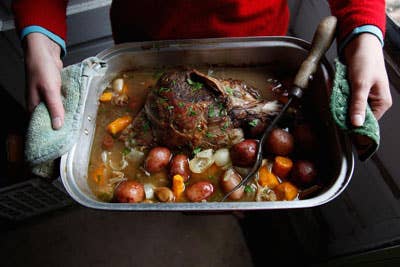
Our Town : A Harvest Potluck Brings a Community Together
A windfall of apples sits on my kitchen counter. It's been gusting outside and I'm glad I had a chance to gather fruit before the fallow season sets in. In a wide pan on the stove, I make a batch of apple chutney (see Recipe: Apple-Cranberry Chutney) to take to a potluck supper later in the day. I wonder what my neighbors are bringing: Becky, down the road, is probably icing her pumpkin cake (see Recipe: Spiced Pumpkin Cake) about now, and I bet Debbie has already put the last of her leek crop into a Crock-Pot. David, whose farm is just across the creek, always digs up some of his waxy Red Norland potatoes for us all to try.
Farming in Oneida County, 250 miles north of New York City, has its challenges. Melons turn to mush when there's too much rain in July. Groundhogs get into the salad beds, and sometimes the tomatoes don't ripen when a frost comes early. But it has been a good year, and on a blustery day like this, at the end of the harvest season, it will be nice to gather with friends for a meal.
When I moved to the Adirondack foothills from Manhattan 12 years ago, I knew almost no one except my husband, whose family settled here in the 1700s. At first, few people waved hello or stopped to chat. And when someone needed directions to where I lived—the postmistress, the grocer, or the veterinarian—all would nod curtly, saying, "Oh, you're in the Murphy's place." How long would it take, I wondered, before that old clapboard house we'd bought was considered ours?
It wasn't easy to adjust. A big night out might be a chicken-and-biscuits fund-raiser at the Fire Hall, advertised roadside on cardboard signs. The supermarket only stocked "frozen at sea" haddock, but the local diner served prime rib—bloody and tender and bigger than a hubcap—for Sunday breakfast. The handyman who fixed up our farmhouse had a bumper sticker under the gun rack on his pickup that read: i didn't claw my way to the top of the food chain to eat vegetables.
"How long is hunting season anyway?" I asked.
"All year," he winked.
I started a garden one spring out of desperation. When the gnarled trees with pretty white blossoms at the back of my field turned out to bear Golden Russets, I learned the hard way—peeling for pies—why their tough skin had earned them the nickname "leathercoats." Eventually, I started paying attention to the handwritten signs next to faded red barns. This led me to the dairy where a gruff old man named Walt would sell me cream or butter straight from his milking shed, and to untended produce stands where I picked up sacks of onions after dropping bills in an honor box. Everyone around here, it turned out, grew something. My new friends Lisa and Mike milked 35 Holsteins twice a day, and Marietta's extended family owned fields next to the West Canada Creek that were rented out for alfalfa; her husband, David, a wood sculptor, grew potatoes on the side.
A few years went by. Word got out that large tracts of land, with soil unsullied by chemical fertilizers, were cheap for the asking. Soon there were more roadside stands and new faces at the Agway where I picked up my gardening supplies. Jordan, a twentysomething local farmer who had recently returned from apprenticing on a biodynamic farm in Virginia, began to sell pasture-raised beef and pork. One of the dairies shifted to making goat cheese and yogurt, and cilantro became easier to find.
At one of our chicken suppers my friend Jim, whose farm dates back to the 1830s and who works as a Cornell University Cooperative Agricultural Extension agent, suggested it was time for a farmers' market. That summer, a few tables were set out on the town square on Saturday mornings. Lisa brought Sweetie 82 corn. Jordan lugged coolers full of chickens. There were fresh eggs, wild elderberries, Concord grapes, paprika peppers. Every Saturday, everyone came to shop, sell, and see one another. At the end of that season, I handed out posters for a harvest potluck.
This year will be our sixth one. It's often the last occasion many of us have to get together until the next year, since by late October, when rain in the valley might turn to snow at our high elevation, it's time for most people to hunker down, get the pumpkins into the barn, and send the lambs off to slaughter. Before that happens, we all spend a day or two cooking and bring covered dishes to the Unity Hall, a 19th-century building that's now used as a day care center and for the occasional party.
The random harmony of potlucks is a universal mystery. I always marvel that we don't wind up with a dozen casseroles. But that's just me, still acting like a food snob from downstate. Marietta might bring a baked cabbage gratin (see Recipe: Red Cabbage Gratin). Lisa uses the last of her corn in a sweet, creamy chowder (see Recipe: Sweet Corn Chowder). The school librarian favors sides from The Moosewood Cookbook, and a local baker donates his dinner rolls and pies. This year, I serve the turkey I usually make with chutney from those tough-skinned apples, and Jim's potatoes come nestled in a pan with roasted lamb (see Recipe: Braised Leg of Lamb).
No one worries about it being a balanced meal. Watching as folks line up to ladle out lamb stew or help themselves to another serving of baked delicata squash, listening as everyone catches up on news about kids and grandparents and work, I feel thankful to have discovered this way to fit into my community.
Keep Reading
Continue to Next Story










